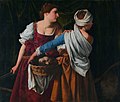Judith and her Maidservant (Gentileschi, Florence)
| Judith and her Maidservant | |
|---|---|
| Judith | |
 | |
| Medium | oil paint, canvas |
| Dimensions | 114 cm (45 in) × 93.5 cm (36.8 in) |
| Location | Uffizi, Italy |
| Coordinates | 43°45′54″N 11°15′00″E / 43.765°N 11.25°ECoordinates: 43°45′54″N 11°15′00″E / 43.765°N 11.25°E |
| Identifiers | Bildindex der Kunst und Architektur ID: 20182659 |
Judith and her Maidservant is a c. 1615 painting[1] by the Italian baroque artist Artemisia Gentileschi. It hangs in the Pitti Palace, Florence.[2]
Subject Matter[]
It depicts the moments after the biblical heroine Judith has assassinated the general Holofernes, and is fleeing his tent with her servant Abra.[1] The subject is one that Artemisia portrayed several times during her career and this portrayal is based on an earlier work by the artist's father:

Judith and her maidservant with the head of Holofernes", c. 1608, by Orazio Gentileschi
The dark setting of the scene is brightened by the red and gold tones in the fabrics - colors which Artemisia used frequently during her time in Florence.[1] The viewer is reminded of the violence which preceded this moment by the screaming head depicted on the pommel of the sword, thought to be a mythological figure such as Medusa.[3]
History[]
The painting was first documented as being in the collection of Grand Duchess Maria Maddalena of Austria,[1] as part of a 1638 inventory.[4] The painting has been altered several times and was likely significantly larger when first created, particularly to the top and the left side of the canvas. The condition of the paint has also been adversely affected by historic conservation efforts.[5]
References[]
- ^ a b c d Treves, Letizia (2020). Artemisia. The National Gallery Company Ltd.
- ^ Christiansen, Keith; Mann, Judith Walker (2001-01-01). Orazio and Artemisia Gentileschi. New York; New Haven: Metropolitan Museum of Art ; Yale University Press. ISBN 1588390063.
- ^ Garrard, Mary D. (1989). The Image of the Female Hero in Italian Baroque Art. Princeton University Press.
- ^ "Immunity From Seizure: Artemisia" (PDF). The National Gallery, London. The National Gallery, London.
- ^ Bissell, R. Ward (1999). Artemisia Gentileschi and the Authority of Art. The Pennsylvania State University Press.
- 1610s paintings
- Paintings by Artemisia Gentileschi
- Paintings in the collection of the Galleria Palatina
- 17th-century painting stubs

